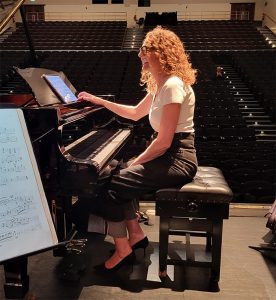Of the three items in the Royal Tunbridge Wells Symphony Orchestra’s latest concert on 3 March, it is perhaps unusual to find that two of them were deemed failures at their first performances. But, you would never have believed that to have been the case on hearing the rapturous applause given by the Assembly Hall audience to all three items in the concert.
Music Director and principal conductor Roderick Dunk led the orchestra through an exciting and exacting programme which contained Wagner’s overture to Rienzi, the Violin concerto by Sibelius, with Fenella Humphreys as soloist, and Tchaikovsky’s Symphony No. 4. The two first performance ‘failures’ were the violin concerto and the symphony – how times, and audience perceptions, have changed!
So what of the polar bears? The excellent Programme Notes written as usual by Tony Summers, a member of the orchestra’s Percussion section, mentioned that the eminent musicologist Sir Donald Tovey, had remarked that the ‘lumbering’ rhythm of the final movement of the Sibelius violin concerto sounded like ‘a polonaise for polar bears’. Whether one could imagine such baltering, ursine antics might be debatable, what was not an issue throughout the entire concerto was the brilliance of the soloist Fenella Humphreys. Her technique and stage presence brought this technically demanding concerto to life and she carried the audience with her throughout the tense, passionate and exhilarating journey. This concerto is acknowledged as one of the most difficult to play, a fact readily understood when you realise that Sibelius, before finally deciding upon being a composer had harboured dreams of becoming a professional violinist. He was good, but in the hands and under the fingers of Fenella Humphreys, Sibelius would not have been disappointed in the final outcome – even if it did have an unappreciative audience at the concerto’s first performance. At the end of the concerto and after the well-deserved applause had subsided, Fenella treated the audience to a beautifully ornamented and unaccompanied encore of the Henry Mancini classic ‘Mood River’. Pure magic!
The concert had started with Wagner’s overture Rienzi. This overture holds a place in history as in 1895 it was the first piece of music played [after the National Anthem] at the inaugural Henry Wood Promenade concert. It is still as popular as ever today although not played as often as one would think or like. On that first occasion it must have been a very nervous trumpeter who started proceedings as the overture commences with an extremely long, drawn-out and very exposed single note. Wagner then repeats this several times over in the twelve or so minutes that the overture takes to play. The performance can quite literally succeed or fail by the way the piece starts. Thank heavens the RTWSO has in Kate Moore, its principal trumpet, such an excellent performer – who displayed no signs of nervousness.
After the interval, the orchestra was certainly put through its paces in Tchaikovsky’s Fourth Symphony. Again, as with the Sibelius concerto, it’s inconceivable to think that this piece was also a failure on its first outing. It is quite a ‘noisy’ symphony, almost rumbustious at times, but there are some quiet, more tender moments verging on pathos, where the orchestra played sympathetically and within itself. But, this symphony really does rely heavily on the woodwind, brass and percussion creating a ‘big’ sound. Such was the intensity of the sound and the almost relentless fast, loud playing that the horn and trumpet sections were augmented with ‘bumpers’ to ease the load on the embouchures of the principals. At the end of the symphony Roderick Dunk acknowledged the woodwind section and particular mention must be made of the piccolo player, Sarah Hein, who had had a very busy afternoon.
This was a ‘lively’ concert with not much opportunity for post-prandial napping!



